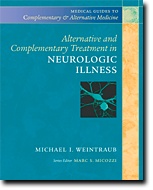Alternative and Complementary Treatments in Neurological Illness
Book Review by Scott Hopkins, DC
| Title: | Alternative and Complementary Treatments in Neurological Illness |
| Author: | Michael Weintraub |
| Publisher: | Elsevier, 2001 |
| Length: | 325 pages |
| Purpose: | Doctor education |
| Price: | $44.95 |
| Part#: | T-241 |
 Chiropractic
is widely considered the most common form of alternative medicine - but
what are the other forms? Most DCs are somewhat familiar with acupuncture
and massage therapy, but have you ever had a patient ask for your thoughts
on magnetic therapy or ayurveda?
Chiropractic
is widely considered the most common form of alternative medicine - but
what are the other forms? Most DCs are somewhat familiar with acupuncture
and massage therapy, but have you ever had a patient ask for your thoughts
on magnetic therapy or ayurveda?
Alternative and Complementary Treatments in Neurological Illness, by Michael Weintraub, is an excellent guide for anyone who wants to broaden his or her knowledge of alternative medicine. Each chapter discusses a specific therapy: acupuncture, therapeutic massage, herbs and supplements, homeopathy, ayurveda, yoga, chiropractic, osteopathy, homeopathy, aromatherapy, placebo, biofeedback, tai chi, qi qong, music therapy, neuro-hypnosis, therapeutic touch, mid-body therapy, auricular acupuncture, Koryo hand therapy, magnetic therapy, and laser biostimulation. There is also a chapter on the legal implications of using these therapies.
Each chapter begins with an in-depth history of the specific therapy. It then explains the underlying concepts and the theory behind them. The main body of each chapter consists of specific neurological illnesses that have seen success with the specific treatment - backed by research, of course. The author then summarizes each chapter, including his opinion of whether the therapy is well-grounded or still under investigation. Depending on the chapter, the author gives the reader basic instructions (and detailed diagrams) to implement the therapy in practice. This is certainly not an alternative to receiving the proper training, but it gives you an idea if it is something you would consider having in your office, or at least referring to.
I was impressed the most by with how clearly each chapter was written. Considering that each chapter is written by a master in its field, the reader is not bogged down by prejudice from someone who may not fully understand or believe the concepts. This also makes the material easy to read and understand. After I read this book, I was so intrigued with qi gong and tai chi that I began learning more about them. I also found myself messing around with the Koryo hand therapy (on myself, of course) during some office downtime.
This book made one point that struck me as odd: Western medicine is the only healing concept that separates mind and body? Considering that many alternative therapies are thousands of years old, while Western medicine is only a few hundred years old, they may know something that we don't.
Not only is this book a great survey of every alternative therapy under the sun (short of blood-letting), but its real intention is to give the reader alternative ways to approach certain neurological illnesses. As a chiropractor, it is imperative that each patient receives the best care possible. Sometimes patients don't respond to chiropractic as well as we would like. Perhaps those patients are great candidates for another type of therapy. We need to do everything we can for our patients, because their health is our top priority. We need to be aware of what else is out there.
Many doctors are interested in incorporating alternative therapies into their practices, but aren't sure what's available. This book is a great starting point and a valuable reference.
Dr. Hopkins' rating:
9.5 out of 10
![]()
Page printed from:
http://www.chiroweb.com/archives/22/02/20.html
